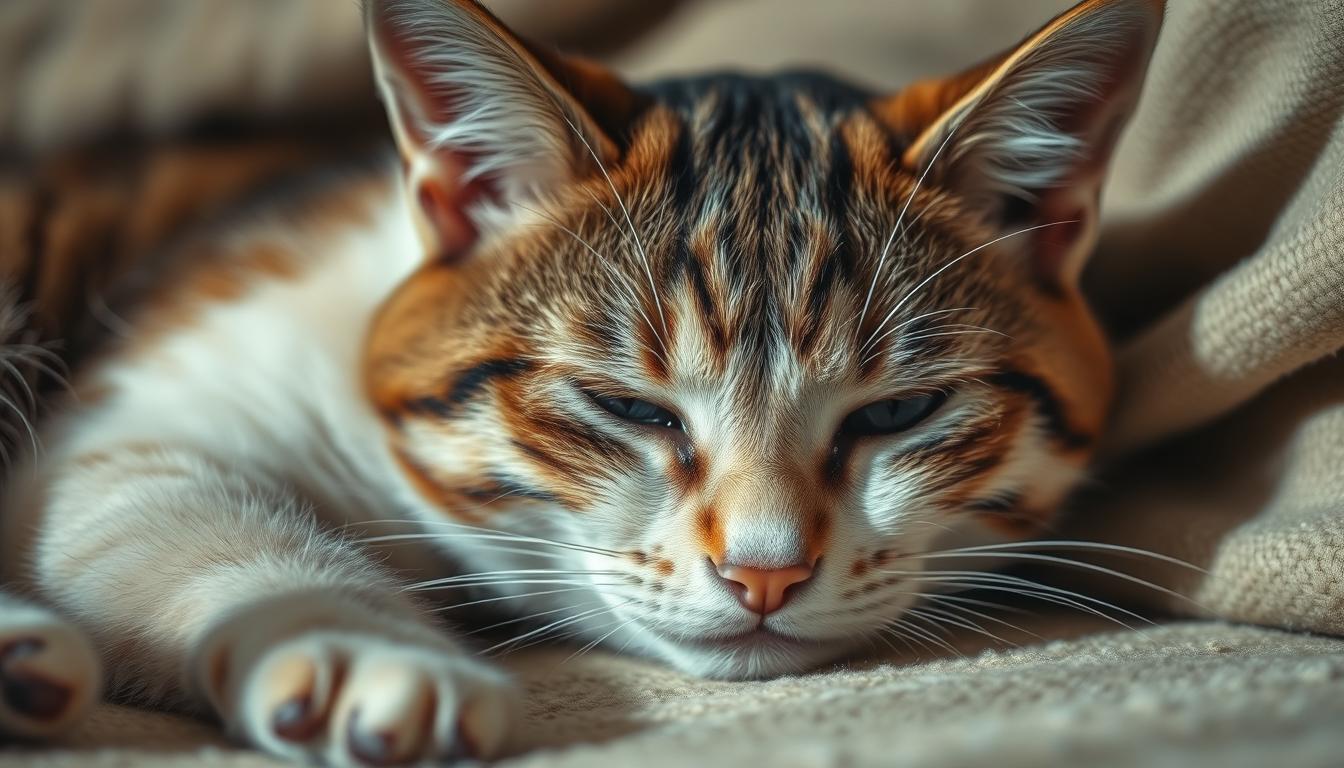Figuring out if your cat is in pain can be tough. Cats are experts at hiding their pain, making it hard to tell if they’re hurting. They stay calm, even when they’re really uncomfortable, because of their natural instincts.
As a cat owner, it’s up to you to watch for signs of pain. Spotting these signs early can help your vet help your cat feel better. This guide will help you understand the signs that your cat might be in pain, so you can take better care of them.
Key Takeaways
- Cats often mask their pain, requiring vigilant observation from owners.
- Recognizing changes in behavior or routine is essential in identifying discomfort.
- Common medical conditions like arthritis and dental disease frequently lead to pain.
- Vocalizations and grooming changes are key indicators of pain.
- Seek veterinary care promptly if you suspect your cat is in distress.
Understanding Feline Pain
Cats often hide their pain, making it hard for owners to notice. It’s important to know the cat discomfort signs and how to spot them. Many think cats don’t feel pain as much as other animals, which can lead to missed treatments. Spotting feline pain indicators is key to keeping them healthy.
Common Misconceptions About Cat Pain
Many believe cats don’t feel pain as much as dogs or humans. This is far from true. Cats hide their pain well, which can cause serious health problems if not treated. This misunderstanding can delay vet visits, hurting our cats’ quality of life.
Types of Pain in Cats
It’s important to know the different types of pain cats can have. There’s acute pain from injuries and chronic pain from long-term issues like arthritis. Spotting these can be tricky, but watching your cat’s behavior can help.
Signs of Acute vs. Chronic Pain
Spotting pain in cats is crucial for their health. Acute pain shows up suddenly, with changes in behavior or activity. Chronic pain is more subtle, showing in grooming habits, appetite, and posture.
Watch for these signs:
| Sign | Acute Pain | Chronic Pain |
|---|---|---|
| Vocalization | Frequent meowing, growling | Unusual quietness, occasional whining |
| Grooming | Reduced grooming, unkempt fur | Excessive grooming leading to patches |
| Posture | Tense body, reluctance to move | Hunched posture, difficulty stretching |
| Behavior | Aggression, regular hiding | Withdrawal from social interactions |
| Activity Level | Sudden decrease in playfulness | Chronic lethargy, avoiding jumping |
Being alert to these signs can help your cat get the care they need. Early action and management are vital for their happiness and health.
Physical Signs of Pain in Cats

It can be hard to tell if a cat is in pain because they often hide it. Physical signs of pain may show up before we even notice. Knowing these signs is key to taking good care of our pets and keeping them happy and healthy.
Changes in Posture or Movement
One clear sign of cat pain symptoms is a change in how they stand or move. Cats in pain might look hunched or arch their backs. They might also not want to jump or play as much.
These signs can mean they’re in pain, like if they don’t want to put weight on a leg. They might also seem tired or sleep a lot more than usual.
Grooming Habits: An Indicator
Watching how a cat grooms itself can tell us a lot about their health. If their fur looks messy, it could mean they’re in pain and can’t groom properly. On the other hand, some cats might groom too much, making things worse.
Changes in grooming are important signs of recognizing pain in cats. They can show us if there’s a bigger health issue.
Your Cat’s Vocalizations
Vocalizations are big cat distress signals. If a cat’s meowing, growling, or purring changes, it could mean they’re in pain or stressed. It’s important to listen to how they sound and what they’re doing.
Unusual sounds might mean they need help fast because of pain. Always keep an ear out for changes in their voice.
Behavioral Changes to Watch For
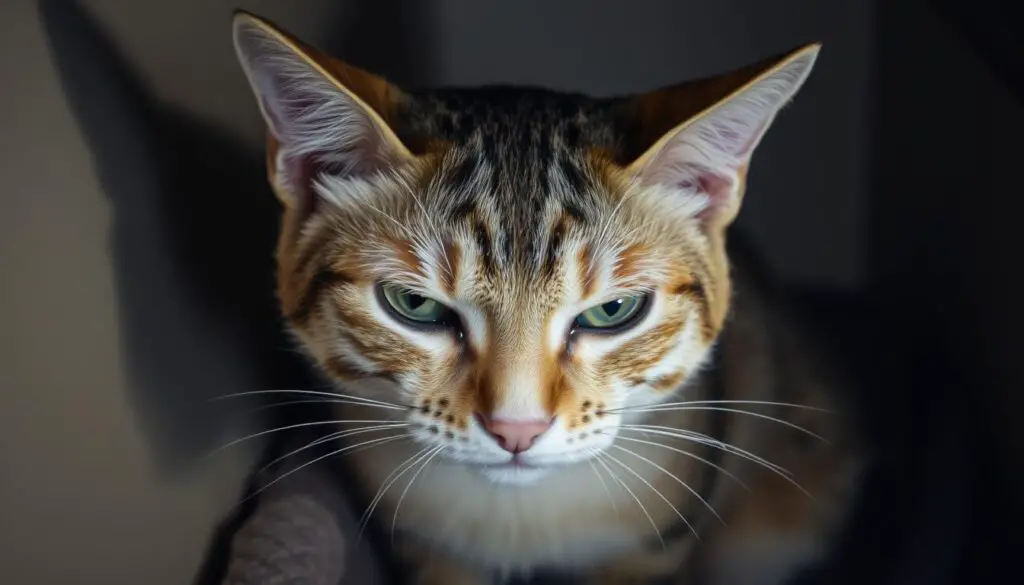
It can be hard to tell if a cat is in pain. But, changes in their behavior can give us clues. Cats are subtle, so we need to watch their daily habits closely. Here are some key signs of pain in cats that every owner should know.
Withdrawal from Social Interaction
A cat in pain might pull away from family. You might see your social cat hiding or staying alone more. This is a way cats protect themselves when they’re not feeling well.
By staying away, they try to avoid stress and save energy.
Altered Eating or Drinking Habits
Changes in eating or drinking can show if a cat is in pain. They might eat less or not want to eat at all. Some cats might even eat more because of stress.
Either way, changes in appetite are important signs. It’s also key to make sure they drink enough water, as pain can make them thirsty and hungry less.
Increased Aggression or Irritability
Pain can make cats more aggressive or irritable. A calm cat might start to hiss, growl, or swat at things. This shows they feel vulnerable or are trying to protect themselves.
If a cat suddenly becomes aggressive, it’s a good idea to see a vet to find out why.
| Behavioral Indicator | Possible Sign of Pain |
|---|---|
| Withdrawal from social interaction | Reduced energy, stress minimization |
| Altered eating/drinking habits | Potential discomfort or nausea |
| Increased aggression or irritability | Defensive reaction to pain |
| Reduced grooming | Indicates possible discomfort |
| Changes in litter box behavior | Discomfort during elimination |
How Cats Communicate Discomfort
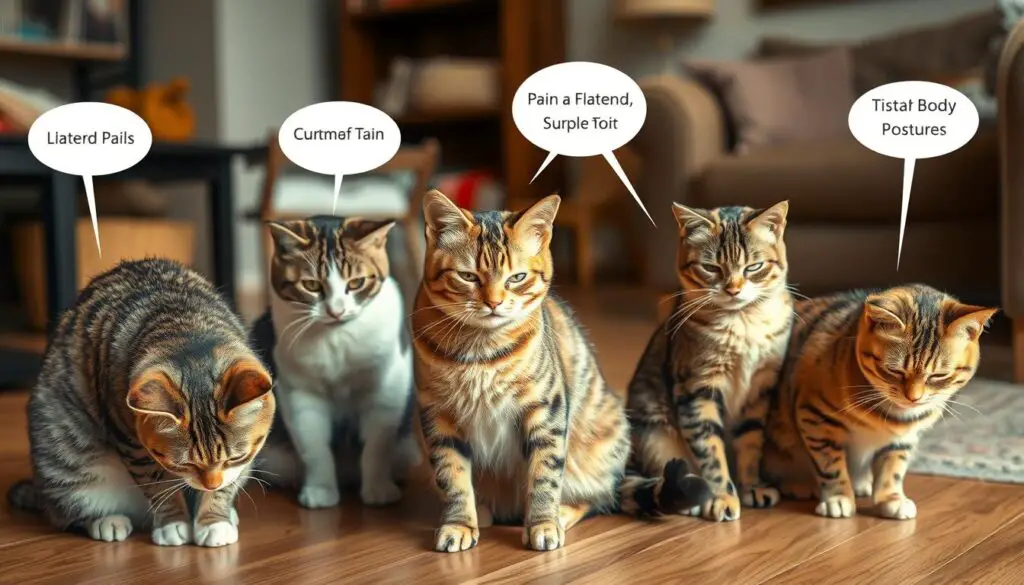
Cats are masters at showing how they feel through subtle signs. Understanding their body language is key to spotting pain. Postures, tail movements, and ear positions all tell a story about a cat’s feelings and health.
The Role of Body Language
Changes in a cat’s body language can mean they’re not feeling well. A hunched back or stiff body might show they’re in pain. It’s important for owners to watch for these signs.
Behavior like hiding or being less active can also mean a cat is in pain. Paying attention to these changes is crucial.
Understanding a Cat’s Tail and Ear Positions
A cat’s tail and ears are great indicators of its mood. A tucked tail can mean anxiety or sickness. Flattened ears often show fear or discomfort.
A swishing tail might mean the cat is upset and needs space. Learning to read these signals helps support your cat better.
Analyzing Changes in Litter Box Behavior
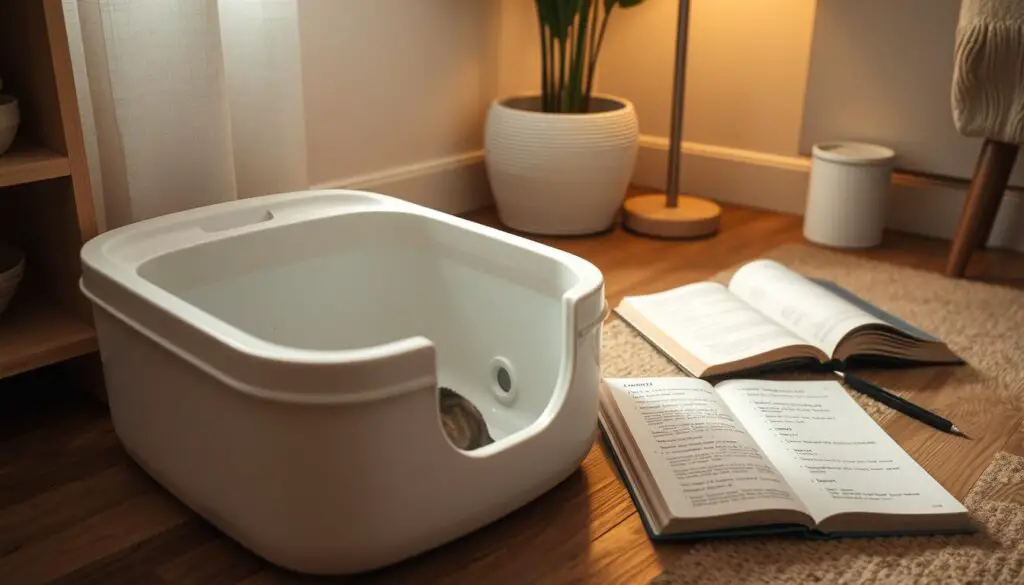
Watching your cat’s litter box habits is key to knowing their health. Changes in how often or how well they use it can mean trouble. It’s important to notice these signs early, as they might show health problems or discomfort.
Frequency and Consistency of Elimination
Cats should go to the litter box regularly. If they don’t, or if they only go to pee or poop, it’s a red flag. Cats might also start to prefer other places to go, like carpets, because they don’t like their litter box.
Keeping the litter box clean and easy to get to is crucial. A dirty or hard-to-reach litter box can make your cat avoid it.
Signs of Straining or Pain During Bathroom Visits
Look out for signs your cat might be in pain or straining. Watch for:
- Struggling to go, which could mean UTIs or other issues.
- Blood in their pee or poop, a sign to see the vet right away.
- Not wanting to use the litter box because it hurts, leading to accidents.
By paying attention to these signs, you can spot health problems early. Having clean, easy-to-find litter boxes helps a lot. Knowing how to read these signs is key to keeping your cat healthy.
Health Conditions That May Cause Pain
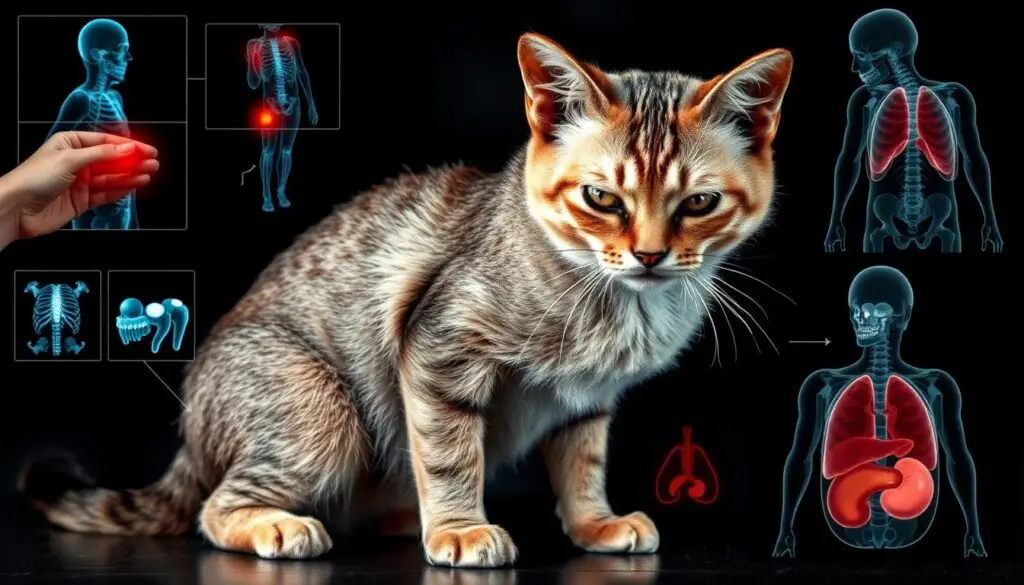
Many health issues can make cats feel uncomfortable. It’s important for cat owners to know about these problems. This way, they can keep their pets happy and healthy.
Some cats might not show they’re in pain. So, it’s key to watch for signs.
Arthritis: A Common Issue in Older Cats
Arthritis, like Degenerative Joint Disease (DJD), is common in older cats. About 70% of these cats have trouble jumping or climbing stairs. They might also change how they groom themselves, with 90% of them showing signs of pain in this way.
Getting your cat to the vet quickly is vital. This helps manage their condition and improve their life.
Dental Problems: More Than Just Bad Breath
Dental issues can cause a lot of pain in cats. This pain can affect how they eat. Around 80% of cats in pain will show changes in their appetite.
Signs like drooling a lot or not wanting to chew can mean dental problems. You should take your cat to the vet right away.
Injuries and Their Impact on Behavior
Acute injuries, like sprains and fractures, can hurt cats a lot. They might cry more, seem tired, or hide. It’s important to notice these signs.
Seeing a vet quickly can help your cat recover better. It can also prevent more serious problems.
| Health Condition | Signs of Pain |
|---|---|
| Arthritis | Difficulty jumping, altered grooming, reduced activity |
| Dental Issues | Appetite changes, excessive drooling, reluctance to eat |
| Injuries | Vocalizations, hiding, reduced energy levels |
Knowing about these health issues can help you care for your cat better. It ensures they live a happy and comfortable life.
The Importance of Regular Vet Check-Ups
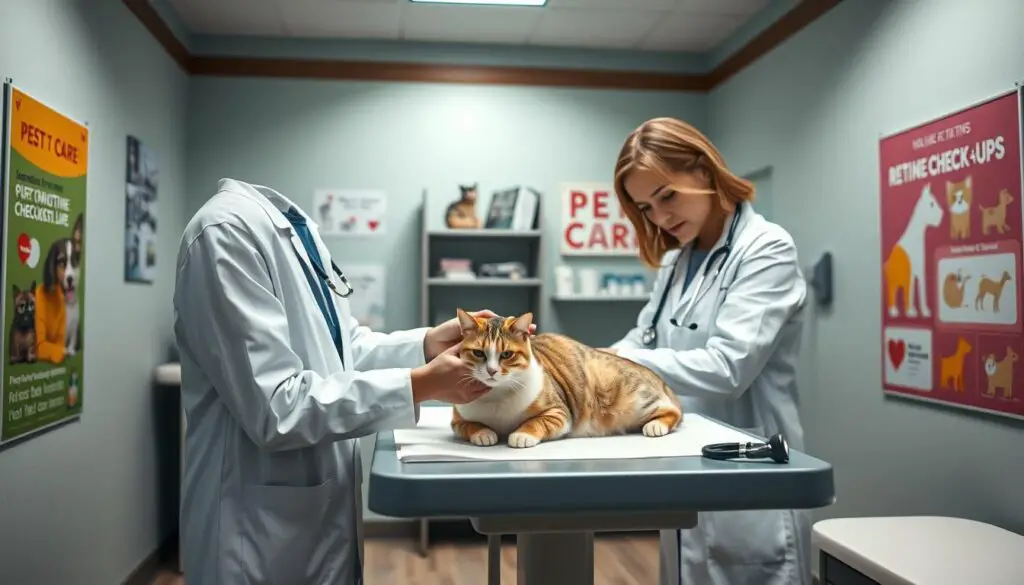
Regular vet visits are key to keeping cats healthy and spotting problems early. These exams help vets find health issues before they get worse. This means better health and a happier life for cats.
Why Routine Exams Matter
Regular vet visits are crucial for cat health. Most adult cats need a vet check once a year. Senior cats should go twice a year.
Vets do many important things during these visits. They check the cat’s body, teeth, and vital signs. They also look at the cat’s skin, eyes, and ears.
These checks can find health problems early. This includes dental issues or signs of aging. Vets also give shots and treatments to keep cats safe from diseases.
How Vets Assess Pain in Cats
Vets have many ways to check if a cat is in pain. They ask about changes in behavior. This could be more grooming or eating less.
| Indicator | Assessment Method |
|---|---|
| Physical examination | Hands-on assessment of body condition and sensitivity |
| Behavioral inquiry | Questions about changes in grooming, purring, and sleeping |
| Dental evaluation | Examination of teeth and gums |
| Weight assessment | Monitoring for significant weight changes |
Knowing about these health checks helps us see why vet visits are important. Finding problems early helps manage chronic conditions. This makes your cat’s life better.
When to Seek Immediate Veterinary Care
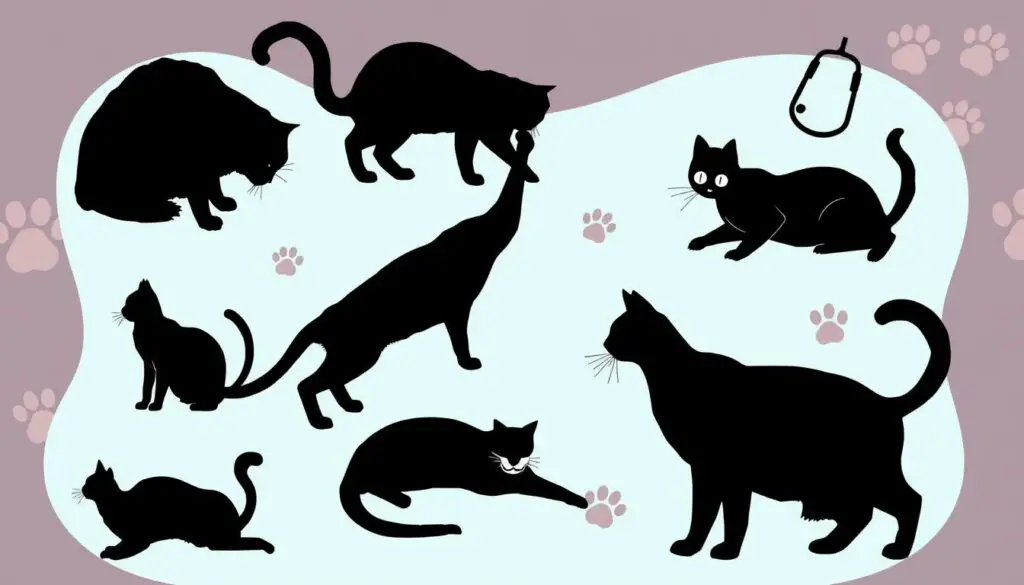
Knowing the signs of emergency cat health issues is key to saving your cat. Spotting certain symptoms early can mean the difference between life and death. Look out for signs of severe distress or injury that need immediate vet care.
Identifying Emergency Symptoms
Being able to spot emergency symptoms is crucial. Here are some key signs to watch for:
- Straining to urinate: Male cats with trouble urinating might have a blocked urethra, a serious issue.
- Severe blood loss: Any big bleeding, from wounds, vomit, or diarrhea, is an emergency.
- Continuous labor: If a cat in labor goes over thirty minutes without a kitten, it’s urgent.
- Collapse: A cat that collapses could have heart, lung, or brain problems.
- Breathing distress: Signs like an elongated neck, panting, and blue-tinged gums mean urgent care is needed.
- Severe vomiting: Often vomiting can lead to dehydration and might mean a blockage.
- Severe pain: If your cat cries when touched or shows distress, it’s likely in a lot of pain.
- Inability to walk: If injuries stop your cat from bearing weight, it could be a fracture or serious injury.
- Hind leg dragging: Sudden leg dragging with loud cries might mean a blood clot.
Understanding the Critical Role of Timeliness
Acting fast can greatly improve your cat’s chances. Keep an eye on your cat’s behavior for any unexpected changes. These could be signs of health problems.
“When in doubt or facing a crisis, contacting the emergency vet for guidance is crucial for appropriate care.”
Pain Management Options for Cats
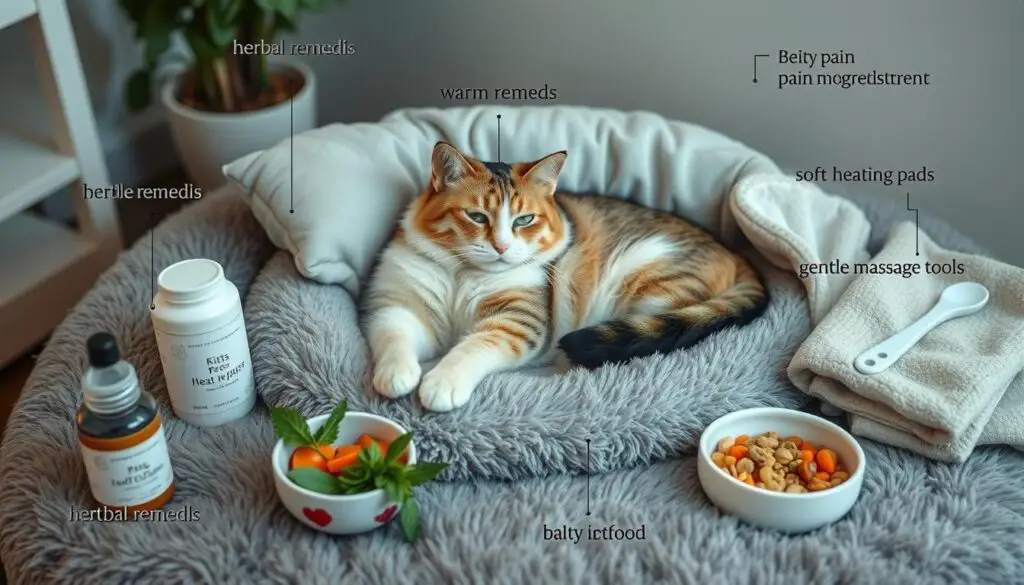
Managing cat pain involves different methods for each cat. Knowing these options helps owners get the best care for their pets. This improves their pets’ lives.
Medications Your Veterinarian May Prescribe
Vets often suggest pain meds for cats. They choose based on the cat’s body. Here are some:
- Nonsteroidal Anti-Inflammatory Drugs (NSAIDs): These are safe for cats’ kidneys.
- Opioids: Buprenorphine and Tramadol work well for severe pain.
- Gabapentin: It’s good for chronic pain, like arthritis.
Finding the right pain relief is key. Cats often hide their pain. Talking often with your vet is important.
Alternative Treatments: Acupuncture and More
There are also non-medical ways to help cats. Some include:
- Acupuncture: It can help with pain and improve movement.
- K-laser therapy: Uses light to heal and reduce pain.
- Pressure point massage: Helps with muscle tension.
| Treatment Type | Description | Benefits |
|---|---|---|
| NSAIDs | Nonsteroidal anti-inflammatory drugs for cats | Works for pain and inflammation without kidney risks |
| Opioids | Medications like Buprenorphine for pain | Good for both acute and chronic pain |
| Gabapentin | Used for chronic pain | Has low side effect risk |
| Acupuncture | Uses needles on body points | Helps with pain and healing naturally |
| K-laser therapy | Light therapy for pain | Safe and effective |
Talking with your vet about pain plans is key. This ensures your cat gets the best care.
The Role of Diet in Managing Pain

Nutrition is key in managing pain in cats, like those with osteoarthritis. The right food can ease discomfort and boost their health. Certain nutrients and supplements can greatly help in dietary impacts on cat pain management.
Foods That Can Help Reduce Inflammation
Choosing the right food is crucial in fighting inflammation. Diets high in omega-3 fatty acids are great for this. Fish oil is a top source of these fats, EPA and DHA.
These fats help keep joints healthy and support a good weight. For cats with arthritis, managing weight through food can improve mobility and reduce pain.
Supplements for Joint Health
Anti-inflammatory cat foods are not the only answer. Supplements like glucosamine and chondroitin sulfate also help. They work together to keep joints lubricated and relieve pain.
These supplements can improve joint function in cats with arthritis. Always talk to a vet for the best diet plan for your cat’s pain management.
Creating a Comfortable Environment for Pain Relief
A safe and nurturing environment is key for cat pain relief. Cats in pain find comfort in cozy spots made just for them. Creating a comfortable space for cats in pain involves several important steps. These steps help them feel secure and reduce their pain.
How to Set Up a Cozy Space
Creating a relaxing space helps your cat deal with pain. Here are some tips:
- Use soft bedding in quiet, draft-free spots for security.
- Add cozy blankets or enclosed beds for warmth and comfort.
- Keep the area quiet, avoiding loud noises or sudden movements.
- Make sure food, water, and litter boxes are easy to reach to reduce stress.
- Try pheromone diffusers to create a calming atmosphere.
Using Heat and Cold for Comfort
Heat and cold therapies can help cats feel better. They meet different needs:
- Heat packs soothe sore muscles. Use them gently on tense or painful areas, but not too hot.
- Cold packs reduce swelling and pain. They’re great for injuries or after surgery.
By creating a caring environment and using heat and cold, you can improve your cat’s recovery. This shows you care about their health. It makes them feel safe and supported when they’re not feeling well.
Emotional Support for Cats in Pain
Caring for a cat in pain is more than just treating physical symptoms. Emotional wellness is key to their recovery. Building a strong bond with your cat can offer comfort and relief. A nurturing environment makes them feel safe, reducing stress and improving their emotional health.
Importance of Bonding and Comforting
Bonding activities for cats in pain should be gentle and reassuring. Spend time with your cat, offer soft petting, or talk in a soothing voice. These moments strengthen your bond and help your cat feel less alone.
Emotional support greatly impacts their ability to handle pain. Every cuddle and word of comfort matters.
Engaging Activities to Distract from Pain
Playful yet gentle activities can distract your cat from pain. Options include:
- Interactive toys that encourage light play without exertion.
- Puzzle feeders to stimulate their mind and provide a small reward for effort.
- Gentle feather wands to invoke a natural hunting behavior in a safe manner.
These activities distract and improve emotional wellness. They add joy to their day and support their healing. Reducing focus on discomfort can improve their mood and vitality.
Monitoring Your Cat’s Progress
It’s crucial to watch how your cat’s pain changes. By noticing any shifts in their behavior or health, you can quickly meet their needs. This also means you can tweak their treatment as needed.
Keeping a Pain Diary
Keeping a pain diary is a big help in tracking cat pain. Write down any changes in behavior, how treatments work, and anything else that stands out. Making regular notes helps spot patterns and see if treatments are working. Here are some important things to jot down in your diary:
- Date and time of observations
- Changes in appetite and drinking habits
- Physical signs such as posture or mobility
- Behavioral traits like social interaction
- Responses to medications or treatments
When to Adjust Treatment Plans
It’s important to check in with your vet often to review your cat’s health and adjusting feline health plans. Knowing when to change treatment depends on several things:
| Criteria | Actions |
|---|---|
| Score of 4 or above on the Feline Grimace Scale | Seek veterinary care immediately |
| Limited improvement in behavior | Review medication or therapeutic options |
| New symptoms arise | Consult vet for a comprehensive evaluation |
| Consistent low energy | Consider alternative pain management strategies |
By keeping a close eye on your cat and adjusting their treatment as needed, you can greatly improve their life and happiness.
The Role of Pet Insurance in Pain Management
Pet insurance can help a lot with the cost of treating your cat’s pain. Many policies cover different conditions, like injuries or chronic illnesses. Knowing what your policy covers is key to taking care of your cat’s health.
Understanding What’s Covered
Pet insurance covers many important aspects of care. You might find coverage for:
- Accident coverage for injuries such as bites, cuts, and broken bones
- Illness coverage for conditions like cancer, arthritis, and urinary tract infections
- Prescription medications for pain management and inflammation
- Behavioral treatments for issues like excessive licking
- Alternative therapies, including acupuncture and physiotherapy
To make sure pet insurance meets your needs, look closely at understanding pain treatment coverage. See what’s covered for ongoing conditions like diabetes and cancer.
How to Navigate Claims for Pain Treatment
Handling claims might seem hard, but it’s crucial for your cat’s care without breaking the bank. Here are some tips:
- Gather all relevant documentation, including vet bills and treatment records.
- Understand the reimbursement process, as many plans operate on a reimbursement basis.
- Keep an eye on co-pays and deductibles to avoid surprises.
- Communicate effectively with your insurance provider to clarify coverage limits.
By exploring pet insurance benefits for cats and learning how to file claims, you can get your cat the best care. Make smart choices to keep them healthy and reduce vet costs.
Learning to Recognize Subtle Changes
Watching your cat’s daily habits closely can really help their health. Spotting small changes early can lead to better care. Regularly checking on your cat helps catch pain signals that might be missed.
Practicing Regular Observation
Knowing your cat’s usual behavior is important. Look out for:
- Vocalizations: More meowing or howling might mean they’re in pain.
- Mobility: Stiffness or not wanting to jump are signs to watch.
- Litter box habits: Changes in how they use the litter box can be a clue.
- Dietary preferences: Eating less might mean they’re in pain or uncomfortable.
Importance of Being Proactive
Keeping an eye on your cat’s behavior is good for their health. It also means you can act fast if something’s wrong. Knowing the signs can stop problems from getting worse. Here are some things to think about:
| Change | Possible Indication |
|---|---|
| Changes in grooming habits | Too much licking might mean pain or skin problems. |
| Alterations in body posture | A hunched back or curled up could mean belly pain. |
| Behavior during interactions | Being more irritable might show they’re in pain. |
| Facial expressions | Looking unhappy or having glazed eyes are clear pain signs. |
By making cat health observation a habit, you can keep your cat happy and healthy. Every small change could be a clue to what your cat needs.
Sharing Your Experience with Other Cat Owners
Connecting with other cat owners can be very helpful. It helps you understand how to manage your cat’s pain better. You can share your experiences and learn from others. Online forums, pet clubs, and social media groups are great places to start.
Resources for Finding Support
There are many ways to find support for cat owners. Here are a few:
- Online forums where pet owners discuss various issues concerning their cats.
- Facebook groups devoted to specific cat breeds or health issues.
- Local veterinary clinics that offer workshops or group discussions on feline health.
- Community events such as pet fairs or adoption events to meet other pet lovers.
Benefits of Community Engagement
Being part of a community has many benefits.
- Sharing pet experiences allows owners to learn from others’ successes and challenges.
- Support networks help reduce feelings of isolation, encouraging collaboration among cat owners.
- Community discussions can lead to better knowledge of signs of pain in cats, helping owners identify issues sooner.
- Increased awareness about different types of pain—like arthritis or dental problems—can promote proactive care.
Conclusion: Keeping Your Cat Happy and Healthy
It’s crucial to know when your cat is not feeling well. This helps keep them healthy and happy. Look out for changes in their behavior, grooming, or litter box use. These signs can mean they’re in pain.
Early detection is important. Many cats with arthritis or other pain issues don’t get diagnosed. This can make them suffer more than they need to.
Regular vet visits are key. They can help find the right pain relief for your cat. Options like Non-Steroidal Anti-Inflammatory Drugs and new treatments like Adequan® and Solensia can really help. Even simple things like laser therapy can improve their comfort and movement.
By taking good care of your cat, you can strengthen your bond. A happy and comfortable cat is a joy to be around. Being informed helps you be the best friend your cat could ask for.
FAQ
How can I tell if my cat is in pain?
What are the common signs of pain in cats?
What should I look for in my cat’s body language?
What are the differences between acute and chronic pain in cats?
When should I seek veterinary care for my cat?
How can I help manage my cat’s pain at home?
What role does diet play in managing my cat’s pain?
Can I use alternative methods to manage my cat’s pain?
How important are regular vet check-ups for my cat’s health?
How can I identify if my cat’s litter box behavior has changed?
What should I do if I notice any subtle changes in my cat?
Source Links
- https://www.petmd.com/cat/symptoms/how-tell-if-cat-pain
- https://www.battersea.org.uk/pet-advice/cat-advice/how-do-i-tell-if-my-cat-pain
- https://www.veterinaryemergencygroup.com/post/6-ways-to-tell-if-your-cat-is-in-pain
- https://www.searshosp.com/site/blog/2022/08/15/signs-pain-cats-what-help
- https://vcahospitals.com/know-your-pet/how-do-i-know-if-my-cat-is-in-pain
- https://animalemergencyservice.com.au/blog/signs-of-pain-in-cats/
- https://www.thesprucepets.com/signs-of-pain-in-cats-4584357
- https://bettervet.com/resources/pet-health-care/signs-of-pain-in-cats
- https://pennypaws.com/blog/9-signs-your-cat-is-in-pain/
- https://www.ctvsh.com/services/cats/blog/7-ways-tell-if-your-cat-pain-some-may-surprise-you
- https://www.averycreekpethospital.com/blog/how-to-tell-if-my-cat-is-in-pain
- https://www.eliteveterinarycare.com/blog/cat-body-language-how-to-tell-when-your-kitty-is-sick
- https://www.petplan.co.uk/pet-information/cat/advice/signs-of-pain-in-cats/
- https://www.aspca.org/pet-care/cat-care/common-cat-behavior-issues/litter-box-problems
- https://www.oregonhumane.org/litterboxproblems/
- https://www.ddfl.org/resources/solving-litter-box-problems/
- https://www.animalhospitalofclemmons.com/site/veterinary-pet-care-blog/2022/07/15/cat-pain
- https://catfriendly.com/keep-your-cat-healthy/know-cat-pain/
- https://www.catster.com/cat-health-care/importance-of-regular-cat-checkups/
- https://www.slatonvet.com/the-importance-of-regular-check-ups-advice-from-a-cat-care-hospital/
- https://anicira.org/resources/10-signs-your-cat-is-having-a-veterinary-emergency/
- https://www.capitalhomevetcare.com/blog/6-signs-your-cat-needs-to-see-a-vet-immediately/
- https://www.veterinaryemergencygroup.com/post/cat-emergency-vet
- https://www.ahofstatesville.com/services/cats/pain-relief-for-cats
- https://vcahospitals.com/know-your-pet/pain-management-for-cats
- https://www.redrocksanimal.com/site/blog/2024/08/15/diet-treat-arthritis-cats
- https://www.petmd.com/cat/general-health/natural-pain-relief-cats
- https://www.litter-robot.com/blog/how-to-tell-if-a-cat-is-in-pain/?srsltid=AfmBOop8dAOP9wj4lnvMhO3_diOVmlhXmPfldCZK1kgFWR2r4wD6G3qJ
- https://catcareclinicbellevue.com/signs-your-cat-might-be-in-pain-a-guide-for-cat-owners/
- https://www.thesprucepets.com/signs-your-cat-is-sick-4165142
- https://www.vergi247.com/helpful-articles/is-your-cat-in-pain
- https://kb.rspca.org.au/knowledge-base/how-can-pain-be-recognised-and-monitored-in-cats/
- https://www.veterinary-practice.com/article/recognising-pain-in-cats
- https://www.aspcapetinsurance.com/research-and-compare/pet-insurance-basics/whats-covered/
- https://www.avma.org/resources-tools/pet-owners/petcare/do-you-need-pet-insurance
- https://southcentralvet.com/blog/10-signs-cat-in-pain/
- https://www.montgomerycountymd.gov/animalservices/Resources/Files/SignsYourCatisinPain.pdf
- https://www.catster.com/felines-weekly/a-cat-owners-manual-for-pain-part-one/
- https://www.lagunacanyonvet.com/site/blog/2023/02/28/signs-pain-cats-help
- https://www.countrysidevets.com/post/cat-pain-awareness
- https://vethelpdirect.com/vetblog/2012/05/02/how-do-you-know-if-a-cat-is-in-pain/
- https://www.lombardvet.com/services/cats/blog/7-ways-tell-if-your-cat-pain-some-may-surprise-you

Hello, this is Frank Swanson, the owner, and operator of Pet Info Hut. I created this website as a way to share my love of pets with the world. I have over 7 years of experience working with animals, and I have a passion for helping people care for their pets. I hope that you find my website useful and informative. Thanks for visiting!

